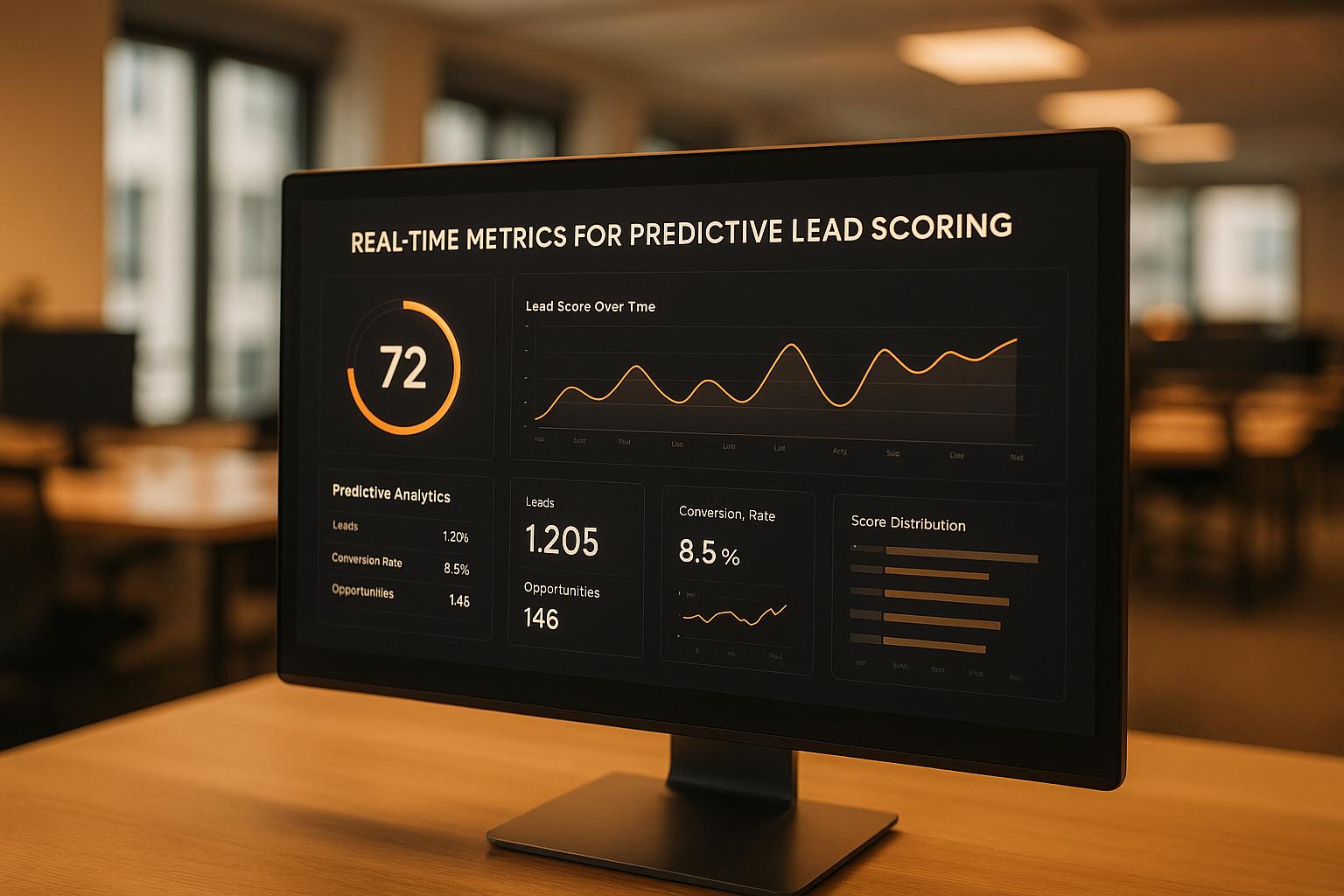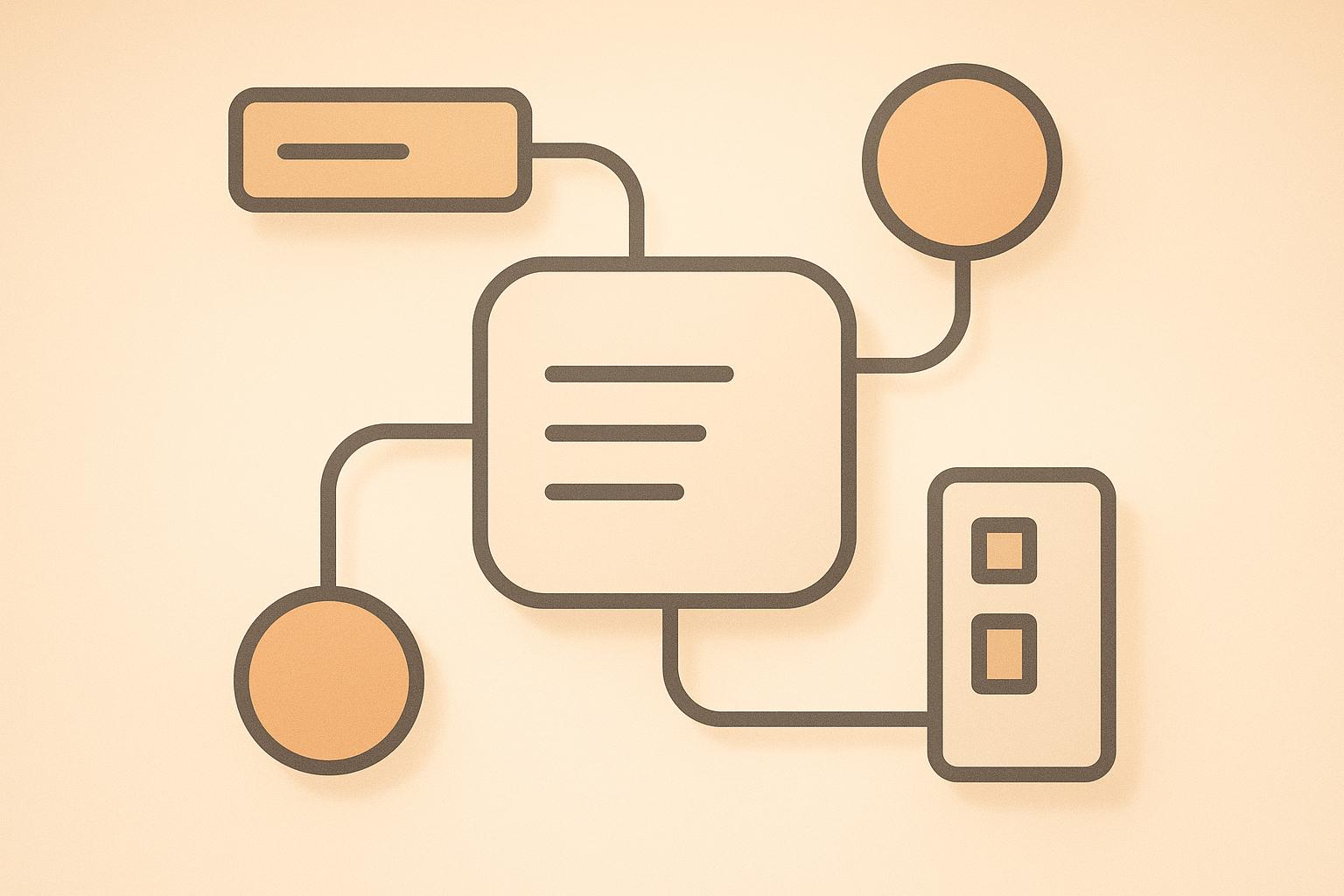
.avif)
Julien Gadea
Julien Gadea specializes in AI prospecting solutions for business growth. Empowering businesses to connect with their audience with SalesMind AI tools that automate your sales funnel, starting from lead generation.
Want to know which leads are most likely to convert? Predictive lead scoring, powered by real-time metrics, is the answer. By analyzing live behavioral data - like website visits, email clicks, and social media interactions - you can prioritize leads instantly and take action when their interest is highest. This method outperforms outdated scoring systems that rely on static, historical data.
Here’s what you need to know:
- Predictive lead scoring uses machine learning to rank leads based on conversion likelihood.
- Real-time metrics (e.g., pricing page visits, email opens, LinkedIn engagement) update scores instantly.
- Benefits for sales teams include faster responses, higher conversion rates, and better prioritization of efforts.
- Tools like SalesMind AI integrate seamlessly with CRMs and LinkedIn to automate scoring and streamline workflows.
This approach keeps your sales team focused on leads that matter most, helping you close deals faster in competitive markets.
Setting Up Predictive Lead Scoring Using Machine Learning
Data Sources for Real-Time Predictive Lead Scoring
To create effective real-time predictive lead scoring, you need a mix of diverse data sources. The better the quality and variety of your data, the more precise your scoring models will be. This precision helps your sales team zero in on the leads most likely to convert, giving them a clear edge in prioritizing efforts. A well-rounded data strategy is the backbone of continuously improving lead scoring models.
Real-Time Engagement Data Types
Tracking real-time interactions is key to understanding prospect behavior. For example, website activity reveals how potential customers interact with your site. Metrics like page views, time spent on specific pages, and the type of content consumed provide valuable clues. If a visitor starts on the pricing page and then dives into case studies, it’s a strong indicator they’re seriously considering your product.
Email engagement is another critical data stream. Tracking open rates, click-through rates, and time spent reading emails paints a picture of interest. The timing and frequency of these interactions also matter - someone who opens multiple emails in quick succession may be more interested than someone engaging sporadically.
Webinar participation adds another layer of insight. While registration shows initial interest, actual attendance and active engagement - like asking questions during a Q&A - signal a deeper level of involvement. Actions taken after the webinar, such as downloading materials or requesting follow-up information, further strengthen the case for prioritizing these leads.
Finally, content downloads offer actionable signals. When prospects download whitepapers, case studies, or guides, they’re actively seeking solutions. The type of content they choose can also indicate their stage in the buying process, helping you tailor your approach.
Combining CRM and Historical Data
Real-time engagement data becomes even more powerful when combined with your existing CRM and historical records. CRM systems hold valuable information like company size, industry, revenue, and growth stage, which adds essential context to current behaviors.
For instance, historical trends might reveal that prospects who attend webinars and download case studies are more likely to convert. This insight allows you to assign more weight to these behaviors in your scoring model, improving its accuracy.
Additionally, past interactions with your brand can provide critical context. A prospect who has engaged consistently over several months likely has stronger buying intent than someone showing similar behaviors for the first time. Long-term engagement often signals deeper interest, even if recent activity isn’t particularly intense.
By merging real-time behaviors with demographic data and historical trends, you can create unified prospect profiles. These profiles give your scoring algorithm the nuanced understanding it needs to make accurate predictions about which leads are most likely to convert.
Data Integration with SalesMind AI

SalesMind AI simplifies the process of collecting and integrating data from multiple sources into a single lead scoring system. For example, it automatically captures LinkedIn engagement data - such as profile views, post interactions, and connection activities - without requiring manual tracking.
The platform’s AI-powered unified inbox consolidates LinkedIn and CRM data into continuously updated prospect profiles. This ensures lead scores are updated in real time, saving sales teams from the hassle of manually compiling data.
SalesMind AI also integrates seamlessly with popular CRM platforms, combining real-time LinkedIn data with customer information like demographics and deal history. This integration ensures every piece of relevant data contributes to an accurate lead score, all while fitting smoothly into your existing workflows.
What sets SalesMind AI apart is its ability to automatically adjust how different data sources influence lead scores. By learning from historical conversion patterns, the system fine-tunes the weight of each engagement signal over time. This means your scoring model gets smarter and more precise without requiring constant manual tweaking. It’s a perfect example of how real-time predictive scoring can streamline lead targeting for sales teams in the US.
How Real-Time Metrics Improve Lead Scoring Models
Real-time metrics take lead scoring to the next level by turning it into a dynamic system that evolves with each prospect's behavior. Instead of relying on static data, these metrics continuously refresh lead scores, offering a more accurate picture of buyer intent. This process hinges on three critical steps: transforming raw engagement data into actionable variables, running real-time scoring workflows, and automating lead prioritization based on these updated insights.
Converting Raw Data into Scoring Variables
To make raw engagement data meaningful, it needs to be transformed into variables that reflect a prospect's level of interest. For instance, session duration can distinguish casual visitors from those deeply engaged. A quick glance at a page might result in a lower score, while an extended visit exploring multiple pages carries more weight.
Click-through rates are another valuable signal. Timing, sequence, and frequency of clicks reveal intent. For example, a prospect who rapidly clicks through several links in an email is likely more interested than someone with sporadic clicks. These patterns are converted into scoring weights that better represent genuine buying interest.
Content consumption also tells a story. Let’s say a prospect downloads a pricing guide, watches a demo, and then visits the contact page - all in one session. This sequence suggests they’re moving closer to a purchase decision. The scoring process also factors in how recent and frequent these actions are, assigning more importance to fresh, repeated interactions over older, less frequent ones.
This transformation lays the groundwork for a scoring system that adapts in real time.
Real-Time Scoring Process
Real-time scoring works by continuously collecting and analyzing data. As prospects interact with your website, emails, social media, or other content, every action is captured and processed instantly.
The system handles multiple activities happening at once. For example, if a prospect engages across several channels - like clicking on an email link, visiting your site, and interacting with a social media post - all those actions are immediately reflected in their lead score. This ensures sales teams always have the most up-to-date view of a prospect's engagement.
Scores aren’t just added up over time. The algorithm reevaluates a prospect’s profile as new data comes in, adjusting earlier scores based on current behavior. So, if someone starts with minimal engagement but suddenly shows strong interest, their priority status updates quickly to reflect that change.
Threshold monitoring plays a key role here. When a prospect’s score surpasses a predefined level, sales teams receive an alert, allowing them to act while the prospect’s interest is at its peak.
The system also uses decay functions to reduce the impact of older interactions. This ensures the focus stays on current buying signals rather than outdated activity.
Automated Lead Prioritization
Once scores are updated in real time, the next step is to automate prioritization. Tools like SalesMind AI monitor when prospects view your LinkedIn profile, engage with posts, or respond to connection requests. These actions are instantly factored into their lead scores.
The system ranks prospects by priority, ensuring sales teams focus on leads with the highest potential. High-scoring prospects are moved to the top of the queue, while lower-scoring ones are directed into nurturing campaigns. This approach maximizes efficiency by concentrating efforts where they’re most likely to pay off.
Dynamic list updates ensure rankings stay current throughout the day. If a prospect takes a significant action - like signing up for a webinar or requesting a demo - their position in the sales queue adjusts immediately.
SalesMind AI also provides intelligent notifications, alerting sales reps when high-value prospects take important actions. By highlighting genuine buying signals, the system helps teams respond quickly without getting bogged down by less critical updates.
Finally, the platform learns from outcomes. When a lead converts, the system reinforces the behaviors that led to success. If a high-scoring prospect doesn’t convert, the algorithm refines itself to reduce similar false positives. Over time, this continuous learning improves the accuracy of lead prioritization, helping sales teams in the U.S. close deals more efficiently.
sbb-itb-817c6a5
Rule-Based vs. Predictive Lead Scoring Methods
Understanding the difference between rule-based and predictive lead scoring is essential for sales teams aiming to boost their conversion rates. While both methods are designed to identify high-quality leads, they differ in how they operate and the results they deliver.
Main Differences Between Scoring Methods
Rule-based scoring is built on fixed criteria defined by sales and marketing teams. Points are assigned to specific actions or traits, such as 10 points for downloading a whitepaper, 15 points for attending a webinar, or 25 points for requesting a demo. These rules remain static unless manually updated.
Predictive scoring, on the other hand, uses machine learning to analyze historical data and identify patterns that drive conversions. Unlike rule-based systems, predictive models continuously adjust as they learn from new data, ensuring the scoring remains aligned with real-time behaviors.
Updating rule-based systems can be time-consuming, as changes in market conditions or customer behavior require manual adjustments. Predictive systems handle this automatically, detecting shifts in what signals buying intent and adapting without human intervention.
Another key difference lies in accuracy. Rule-based scoring often reflects assumptions about what indicates interest, while predictive scoring relies on data to reveal what truly drives conversions. This makes predictive scoring a better tool for prioritizing leads.
Scalability is also a major factor. Rule-based systems can become overly complex as more variables are added, making them harder to manage. Predictive systems thrive on complexity, analyzing numerous variables with minimal effort from the user.
Comparison Table: Rule-Based vs. Predictive Scoring
Here’s a side-by-side breakdown of the key differences:
| Aspect | Rule-Based Scoring | Predictive Scoring |
|---|---|---|
| Data Analysis | Relies on manually created rules | Uses machine learning to analyze historical data |
| Scoring Method | Assigns fixed points to predefined actions | Dynamically adjusts based on conversion data |
| Flexibility | Requires manual updates for changing conditions | Adapts automatically to new data |
| Complexity Handling | Becomes harder to manage with more variables | Handles complexity effortlessly |
| Accuracy | Based on assumptions and intuition | Driven by actual conversion outcomes |
| Initial Setup | Quick to set up with simple rules | Requires historical data for setup |
| Ongoing Adjustments | Needs frequent manual updates | Self-optimizes with little maintenance |
| Real-Time Updates | Static until updated manually | Continuously learns and adapts |
Why Predictive Scoring Works Better
Predictive scoring offers clear advantages in fast-changing sales environments. By focusing on proven data patterns rather than human assumptions, it removes bias and delivers more reliable results. This approach is especially useful for uncovering hidden trends. For example, machine learning might reveal that prospects browsing pricing pages on mobile devices are more likely to convert than those on desktops, or that engagement during certain times of the day signals stronger buying intent - insights that are often missed with manual rule-setting.
Another benefit is real-time adaptability. Predictive systems automatically adjust to shifts in buyer behavior or market conditions, while rule-based systems rely on outdated assumptions until someone updates them. This ability to evolve ensures that predictive scoring stays relevant and effective.
Moreover, predictive scoring improves over time through continuous learning. Each new interaction feeds the model, refining its accuracy. In contrast, rule-based systems remain static, unable to benefit from fresh data.
For example, SalesMind AI applies predictive scoring to LinkedIn engagement data, analyzing factors like profile activity, connection patterns, and response history. The platform identifies which prospects are most likely to engage in real time, helping sales teams focus their efforts where they matter most.
For U.S. sales teams in competitive markets, predictive scoring provides a critical advantage. It pinpoints leads who are ready to buy now, rather than simply matching a predefined profile. Over time, the algorithm becomes more attuned to the unique factors that drive success for your product and market, ensuring you stay ahead of the competition.
Best Practices for Real-Time Predictive Lead Scoring
Real-time predictive lead scoring works best when built on solid data practices and ongoing performance monitoring.
Data Preparation for Lead Scoring
Start by establishing clear data collection and maintenance protocols. Use consistent formats for all prospect interactions - for instance, standardizing company names across records.
The amount of historical data needed can vary. Most predictive models require at least 1,000 lead records with known outcomes to generate reliable scores. For B2B companies, which often have longer sales cycles, this means gathering 6-12 months of data. In contrast, B2C businesses, with typically shorter cycles, may only need 3-6 months of data to achieve accuracy.
Automate data quality checks to catch incomplete records, duplicate entries, and errors like email addresses missing the "@" symbol or invalid phone numbers. These validation processes should run continuously, ensuring data remains clean over time.
When initial prospect information is limited, data enrichment tools can fill in missing details like company size, industry, or technology stack. This added context helps improve the predictive model’s scoring accuracy.
Also, consider data retention policies that balance the need for accuracy with storage costs. While recent data is often more impactful for scoring, older records can reveal long-term trends and seasonal patterns, offering valuable insights.
Once your data is clean and consistent, the next step is to fine-tune your predictive model for optimal performance.
Model Performance Optimization
With a strong data foundation in place, focus on refining your model. Monitor its accuracy regularly and experiment with different configurations, such as scoring thresholds, feature weights, and update frequencies. You can also create composite metrics, like engagement velocity, to improve predictive precision.
The frequency of model retraining should match your industry’s pace. In fast-changing markets, monthly updates may be necessary, while more stable sectors could manage with quarterly retraining. Keep an eye on performance metrics to identify when retraining is needed.
Ensure compliance with U.S. privacy laws like the CCPA by implementing consent mechanisms and clear data deletion procedures. Maintain detailed documentation of data processing activities to support regulatory audits.
Regular score calibration is essential to ensure predictive scores align with actual outcomes. For example, a lead scored at 85 should consistently have a higher conversion likelihood than one scored at 65. Calibration checks help fine-tune the model and maintain its reliability.
Implementation with SalesMind AI
After optimizing your model, seamless integration into workflows is key. SalesMind AI simplifies this process by offering tools for data integration, model management, and score delivery.
SalesMind AI’s advanced lead scoring evaluates multiple data points at once, such as profile activity, message response times, and connection acceptance rates. This multi-layered analysis helps sales teams focus on prospects who are genuinely interested, not just active.
The unified inbox feature combines lead scoring with workflow management. For instance, if a prospect’s score increases due to recent LinkedIn activity, the platform prioritizes their messages and suggests the best time to follow up. This eliminates delays between insights and actions.
Through LinkedIn integration, SalesMind AI updates scores based on behaviors like profile views, content engagement, or connection requests. When engagement spikes, the platform notifies your sales team, ensuring timely follow-up.
CRM integration ensures lead scores remain consistent across your sales tools. Scores update automatically in your CRM, helping sales reps prioritize tasks based on the latest insights.
Finally, lead tracking provides a clear view of how scores change throughout the sales journey. Teams can identify which activities boost scores and adjust their strategies accordingly. This feedback loop not only improves the predictive model but also sharpens sales tactics over time.
With its LinkedIn integration and automated follow-up triggers, SalesMind AI ensures high-value leads are addressed immediately. By combining data-driven insights with seamless automation, SalesMind AI enables U.S. sales teams to act quickly and effectively on predictive scores.
Conclusion
Real-time predictive lead scoring isn't just about keeping up with technology - it's about staying ahead in the competitive world of modern sales. By adapting to every new interaction and market trend, this approach reshapes how businesses identify and prioritize leads, giving U.S.-based companies a clear edge in driving sales efficiency [1].
Why Real-Time Predictive Lead Scoring Matters
With real-time predictive lead scoring, businesses gain the ability to define lead quality using data-driven metrics. These systems can automatically route leads based on factors like deal size, industry, and location, ensuring that the right opportunities land in the right hands. By analyzing multiple interactions, they provide clear insights into when key decision-makers are actively engaged, signaling a serious buying intent. Plus, their ability to learn and improve over time enhances both scoring accuracy and the reliability of sales forecasts [1]. This means sales teams can concentrate their efforts on leads that truly matter [2]. It's a game-changer for anyone looking to maximize their sales potential.
Start Your Journey with SalesMind AI
SalesMind AI makes advanced predictive scoring accessible - even for those without a tech background. With tools like LinkedIn integration and an intuitive lead scoring system, it helps pinpoint high-intent prospects. Its unified inbox takes things further by prioritizing leads and recommending the best times to follow up.
The platform takes care of data integration, model management, and score delivery, leaving sales teams free to focus on closing deals. Ready to upgrade your sales strategy? Discover how SalesMind AI can transform your approach by visiting https://sales-mind.ai.
FAQs
What makes real-time predictive lead scoring more effective than traditional rule-based methods?
Real-time predictive lead scoring leverages machine learning and live data analysis to evaluate leads on the fly, adjusting to fresh engagement signals as they come in. Unlike traditional rule-based methods that depend on fixed, manually set criteria, this approach delivers sharper and more timely insights.
By constantly analyzing behaviors and patterns, real-time scoring pinpoints high-quality leads more quickly, allowing businesses to concentrate their efforts where they’ll have the biggest impact. Traditional methods, with their static and rigid setups, often fail to catch these opportunities.
What types of data are crucial for enhancing the accuracy of predictive lead scoring models?
The effectiveness of predictive lead scoring models hinges on a few critical types of data:
- Behavioral data: This tracks actions like website visits, email clicks, and content downloads, offering a window into a prospect's engagement and intent. It's like reading the digital footprints they leave behind.
- Demographic data: Details such as age, location, and other personal attributes help pinpoint and segment target audiences more effectively.
- Firmographic data: For B2B sales, information like a company's industry, size, and revenue is essential for narrowing down potential leads.
- Historical interaction data: Pulled from tools like CRM and marketing platforms, this data highlights past interactions, providing context for predicting future behavior.
Of these, behavioral data stands out for its ability to capture real-time intent. It enables businesses to zero in on high-value leads, fine-tuning their sales efforts for better results.
How does SalesMind AI's LinkedIn integration improve lead scoring for sales teams?
SalesMind AI's LinkedIn integration takes the hassle out of lead scoring by automatically collecting and analyzing real-time engagement data directly from LinkedIn. This means your sales team can quickly pinpoint and prioritize the prospects most likely to turn into valuable customers, saving time and improving overall efficiency.
With enriched lead profiles packed with actionable insights, SalesMind AI helps your team zero in on the most promising opportunities. This sharper focus not only improves targeting but also increases the chances of closing deals effectively.




